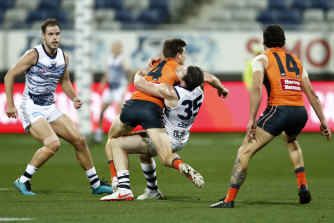Greenes two-game ban reduced as Giants consider further appeal
GWS star Toby Greene is free to play in the Giants’ final-round crunch match against Carlton, but not this week against Richmond, after downgrading his two-match ban to one game for striking Patrick Dangerfield.
However, the Giants will consider an appeal to further downgrade the penalty to a fine so Greene can play the Tigers.
The match review officer suspended Greene for two matches for the incident, deeming it careless conduct, high impact and high contact. Greene got the impact of the incident moved down from “high†to “medium†but did not successfully argue the incident was not careless.

Toby Greene catches Patrick Dangerfield high as he tries to fend off a tackle.Credit:Getty Images
At the AFL tribunal on Tuesday night, the jury of Stewart Loewe, Shane Wakelin and Richard Loveridge - chaired by Ross Howie - made the judgement.
Greene pleaded not guilty to the charge, arguing that his action was “not carelessâ€. His legal counsel, former AFL footy operations boss Adrian Anderson, also said it should have been medium impact and not high because Dangerfield was able to play this week.
Dangerfield’s medical report found that the Cats midfielder had a “laryngeal bruise†but not a fracture of his larynx. He is OK to keep training and is not expected to miss any games, the Cats said. Dangerfield did not play on in Friday’s match after the incident, receiving treatment in hospital overnight.
“A reasonable player would not regard it as prudent to adopt the technique that Toby Greene adopted here ... this was high contact that happened because of an inherently dangerous technique. Not because of some so-called ‘football incident’ ... or reflex action,†AFL counsel Jeff Gleeson said.
“It was pretty quickly apparent Greene would get there first [and that he knew a Geelong player was coming to tackle him].â€
Gleeson said tackling technique training usually dictates a tackler would “go lowâ€, like Dangerfield did, and so that Greene should have known his elbow could have hit higher than his opponent’s chest on the neck, chin or head.
“It [Greene’s conduct] is inherently dangerous, it caused an injury, it could have caused a worse injury.â€
It was high impact, Gleeson said, because Dangerfield went to hospital and did not return to play.
Anderson argued Greene’s conduct was a split second decision, instinctive and reasonable reaction to the situation and that:“Patrick Dangerfield slipped at a crucial moment which contributed to the contact which could not have reasonably been foreseenâ€.
“His [Greene’s] forearm and elbow never go above his shoulder height,†Anderson said.
The slide, Anderson said, made Dangerfield go “unusually low†into the contest, almost falling back before contact was made, as opposed to pushing upwards of his right leg.
“It could not have been foreseen,†he said. “He was attempting to legitimately fend off his opponent’s upper chest.â€
Gleeson argued Dangerfield’s head did not get significantly lower at any point because of the slip.
That Greene stayed low and did not leave the ground also counted in Greene’s favour, according to the GWS argument.
Anderson also referred to Dangerfield not being suspended for his forearm on Nick Vlastuin, which concussed the Tigers player, in the early stages of the 2020 grand final.
“Whilst contact to the throat no doubt can be painful [and cause serious injury] ... this is not a case of contact to the head [therefore it should not be considered high impact],†he said.
Neither legal counsel sought comment from Greene during the hearing.
Anthony Colangelo is a sports reporter at The Age.

0 Response to "Greenes two-game ban reduced as Giants consider further appeal"
Post a Comment